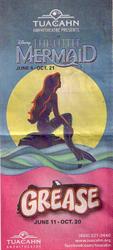
|
|
Tuacahn Amphitheatre 1100 North Tuacahn Drive Ivins, Utah 84738 1-800-746-9882 tuacahn.org (1995) |
After moving to St. George in 1983, Doug Stewart began thinking about creating an outdoor theatrical venue. “Here you have 3 million-plus going through the gates of Zion National Park each year, and I asked myself, `Why aren't we providing something for these people at night?'''[1]
In 1991, Stewart drove to a canyon with “a broad bowl of space” surrounded by sandstone cliffs like “a high mountain fortress, blocks of red stone, rooted in time, with pocks of wind-blown texture accentuating the surface.” Standing in this “natural amphitheater”, he pictured “the wings of a stage growing out of the stone and sand before him, and hundreds of seats cropped up around him in the almost concave form of the hill. From cliff to cliff, he could hear the echoes of often-told and ancient stories, a heritage of the conscious past . . . the images of native blood and pioneer spirit, folding and dodging through the landscape, spilling the pain and joy of generations onto the canyon's solid canvas of sand and stone - and water, gushing from rocks in a wellspring of aspiration.”[2]
Stewart wanted a name for the amphitheater that had a “Native American feel,” so he “massaged” a Mayan word for “canyon of the gods” to create “Tuacahn.”[1]
Encouraged by friends, Stewart began exploring funding possibilities. The Heritage Arts Foundation was founded in September 1991, with the goal of preserving “historical and cultural heritage through the arts, and to promote character and lasting values through the development of talents.”[1]
Hyrum Smith of Franklin Quest, and others, helped provide the resources that made Tuacahn a reality.[2]
Construction began in June 1993, but was halted in May 1994 when two desert tortoises were found dead on the facility's entry road. Tuacahn spent “hundreds of thousands of dollars in legal fees and the cost of implementing a habitat conservation plan.”[1] To protect the endangered species of tortoise, a fence was constructed along the road leading to the amphitheater.[3]
The Tuacahn Amphitheater and Center for the Performing Arts is located in the box-shaped Padre Canyon, near the south entrance of Snow Canyon, 10 miles northwest of St. George.[1][4] When Doug Stewart discovered the location, the 80-acre site was owned by Orval and Ruth Hafen, who had built a cabin below the 1,500-foot red rock cliffs.[5]
The $20-million performing arts complex features a 1,920-seat[5] amphitheater with “all the amenities necessary for major musical and stage productions.” When the facility opened, it had a state-of-the-art music school in a 42,000-square-foot building, with theaters, dance studios, recording studio, teaching studios, recital room, and a shop for fixing instruments. One of the dance studios could be adapted into banquet facilities for large gatherings. Expansion plans included student housing for summer music camps, a 1,000-seat theater and concert hall, and a visual arts building.[1][2]
The gala opening for Tuacahn began on 5 April 1995, with the Utah Symphony performing the “Tuacahn Overture” by Kurt Bestor and Sam Cardon.[1] On 8 April 1995, President Gordon B. Hinckley of The Church of Jesus Christ of Latter-day Saints offered the dedicatory prayer, followed by a performance of the Mormon Tabernacle Choir.[4]
Speaking of the pioneers from the area, President Hinckley said, “Jacob Hamblin and Dudley Leavitt and others with him walked back and forth across this desert land from Cedar City to Las Vegas. They had floods, drought, pestilence, but they kept the faith. . . . We remember them with grateful respect, and now we have pioneers of a different kind. A new generation has created this great facility, desiring to share it with the travelers. . . . It is fitting for the Tabernacle Choir to be present for these dedicatory ceremonies, for this (canyon) too is a tabernacle, a part of the divinity that is within each of us.”[4]
When planning Tuacahn, Doug Stewart envisioned “an outdoor historical drama that would be second to none in the country, in which special effects and entertainment value would be paramount - because of our close proximity to Las Vegas.”[1]
Opening on 23 June 1995, UTAH! told the story of Jacob Hamblin, who was sent by Brigham Young to supervise the early settlements in Southern Utah. Events covered by the musical included the Mountain Meadows Massacre, Johnston's army, the Navajo uprising, and the flood of 1862. Tuacahn's “signature special effect” featured a recreation of the Santa Clara River, with 30,000 gallons of water rushing down the hillside, washing over the stage toward the audience, and destroying a stone fort. The production continued through 1998 and featured a cast of 80 and music by Kurt Bestor and Sam Cardon.[1 & 6]
Tuacahn experienced a real flood on 6 September 1995, after two inches of water fell in one hour. Mud, debris, and water reached up to row H of the amphitheater and flooded the Black Box Theater, the Hafen Theater, and several classrooms. Mary Stewart, director of the Tuacahn School of the Arts, said, “It filled doorways about halfway up with water on top of the mud. It was as though half the mountain caved in.” The road to the facility was closed by debris.54] The floor of the Hafen Theatre stage had to be dismantled, dried, and replaced. The cast and crew of “The Fantasticks” rehearsed between shifts of shoveling mud.[6]
1. "Overtures to Garnish Opening of Tuacahn", Deseret News, 2 April 1995, page E3
2. "A Dream Springs Into Being at Tuacahn", Deseret News, 14 April 1995, page C1
3. "Storm Sends Wall of Red Mud into Tuacahn Amphitheater", Deseret News, 7 September 1995, page A1
4. "New Utah Art Center is Dedicated", Deseret News, 10 April 1995, page A1
5. “History”, tuacahn.org, accessed October 2011
6. "Tuacahn Theater to Show 'Fantasticks' 8 Times", Deseret News, 4 October 1995, page C7
